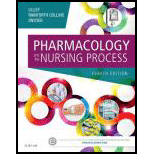
To discuss:
The general principles of antibiotic therapy.
Concept introduction:
An antimicrobial substance that is active against most of the bacteria is known as an antibiotic. It is useful in controlling and preventing the infections caused by bacteria. Antibacterial agents act by killing the bacteria or inhibiting their growth. Penicillin, amoxicillin, and levofloxacin are some of the examples of antibiotics.
Explanation of Solution
The general principles of antibiotic therapy are given below:
Diagnosis: Infectious agents that are responsible for the disease, site of infection and drug of choice are assessed before the antibiotic therapy.
Decision on chemotherapy: Acute infection needs chemotherapy, whereas chronic infections do not require chemotherapy. However, chemotherapy is recommended for chronic abscess after surgery for avoiding further infection.
Selection of drug: Specificity of the drug, pharmacokinetic factors (physical and chemical properties) and features associated with patients like drug allergies and diseases are considered while choosing a drug.
Regularity and period of drug administration: Optimal dose recommended by the physician must be taken by the patient. The inadequate dose of the drug will result in resistance. The intermediate dose will not be sufficient for treating the infection.
Continuation of therapy: Treatment for acute infection is given for 5 to 10 days. Some of the bacterial infections like tuberculosis, typhoid fever, and infective endocarditis have been treated for months.
Testing for a cure: Signs and symptoms might disappear before the eradication of pathogen. Therefore, a laboratory test is done to make sure that the infection is resolved.
Prophylactic chemotherapy: The term prophylactic means preventive. Prophylactic is a medication or therapy planned and used for preventing the disease from occurring.
The general principles of the antibiotic therapy are explained. These principles are important while prescribing an antimicrobial therapy to a patient.
Want to see more full solutions like this?
Chapter 38 Solutions
Pharmacology and the Nursing Process, 8e
 Phlebotomy EssentialsNursingISBN:9781451194524Author:Ruth McCall, Cathee M. Tankersley MT(ASCP)Publisher:JONES+BARTLETT PUBLISHERS, INC.
Phlebotomy EssentialsNursingISBN:9781451194524Author:Ruth McCall, Cathee M. Tankersley MT(ASCP)Publisher:JONES+BARTLETT PUBLISHERS, INC. Gould's Pathophysiology for the Health Profession...NursingISBN:9780323414425Author:Robert J Hubert BSPublisher:Saunders
Gould's Pathophysiology for the Health Profession...NursingISBN:9780323414425Author:Robert J Hubert BSPublisher:Saunders Fundamentals Of NursingNursingISBN:9781496362179Author:Taylor, Carol (carol R.), LYNN, Pamela (pamela Barbara), Bartlett, Jennifer L.Publisher:Wolters Kluwer,
Fundamentals Of NursingNursingISBN:9781496362179Author:Taylor, Carol (carol R.), LYNN, Pamela (pamela Barbara), Bartlett, Jennifer L.Publisher:Wolters Kluwer, Fundamentals of Nursing, 9eNursingISBN:9780323327404Author:Patricia A. Potter RN MSN PhD FAAN, Anne Griffin Perry RN EdD FAAN, Patricia Stockert RN BSN MS PhD, Amy Hall RN BSN MS PhD CNEPublisher:Elsevier Science
Fundamentals of Nursing, 9eNursingISBN:9780323327404Author:Patricia A. Potter RN MSN PhD FAAN, Anne Griffin Perry RN EdD FAAN, Patricia Stockert RN BSN MS PhD, Amy Hall RN BSN MS PhD CNEPublisher:Elsevier Science Study Guide for Gould's Pathophysiology for the H...NursingISBN:9780323414142Author:Hubert BS, Robert J; VanMeter PhD, Karin C.Publisher:Saunders
Study Guide for Gould's Pathophysiology for the H...NursingISBN:9780323414142Author:Hubert BS, Robert J; VanMeter PhD, Karin C.Publisher:Saunders Issues and Ethics in the Helping Professions (Min...NursingISBN:9781337406291Author:Gerald Corey, Marianne Schneider Corey, Cindy CoreyPublisher:Cengage Learning
Issues and Ethics in the Helping Professions (Min...NursingISBN:9781337406291Author:Gerald Corey, Marianne Schneider Corey, Cindy CoreyPublisher:Cengage Learning





